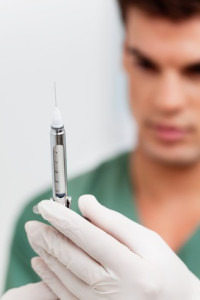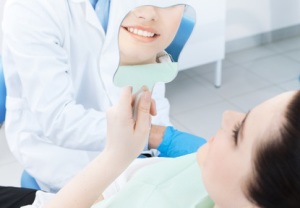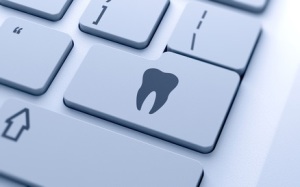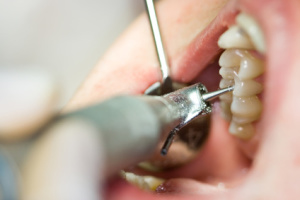From time to time I like to read articles from my Alma Mater, University at Buffalo School of Dental Medicine, recently I came across an interesting article. Dr. Sebastian Ciancio, DDS has recently published an article about the use of a nasal spray to anesthetize upper teeth as opposed to dental injections. The study is centered around how safe and effective using a nasal spray to numb the upper teeth rather than an injection to the area. This study is now in the second phase of research by the Food and Drug Administration. So what does this mean for your dental future? Well, there is a possibility that in the future you may be able to forgo the need for injections with some procedures. This is a great option for dentists and needle phobic patients alike and may help patients seek dental care more frequently. Things that remain to be seen is duration of numbness, localization of numbness as well as possible side effects, and long term effects. But in general there are many great things on the horizon for dentistry and I, along with many others, am eager to see what is in store!
]]>
The study is centered around how safe and effective using a nasal spray to numb the upper teeth rather than an injection to the area. This study is now in the second phase of research by the Food and Drug Administration. So what does this mean for your dental future? Well, there is a possibility that in the future you may be able to forgo the need for injections with some procedures. This is a great option for dentists and needle phobic patients alike and may help patients seek dental care more frequently. Things that remain to be seen is duration of numbness, localization of numbness as well as possible side effects, and long term effects. But in general there are many great things on the horizon for dentistry and I, along with many others, am eager to see what is in store!
]]>
Posts
There is a lot of anxiety surrounding the dental injection process. Whether it be from the  expectation of pain from the needle or the anxiety around being numb for an extended period of time, there are a lot of things that can cause distress prior to receiving an injection. So here are some frequently asked questions about what to expect from a dental injection as well as what you should expect to experience afterwards.
expectation of pain from the needle or the anxiety around being numb for an extended period of time, there are a lot of things that can cause distress prior to receiving an injection. So here are some frequently asked questions about what to expect from a dental injection as well as what you should expect to experience afterwards.
-
What are you injection me with?
The days of novacaine are long gone, now most dentists will use anesthetics such as lidocaine, mepivicaine or prilocaine. These anesthetics are available with or without a small amount of epinephrine. -
Why do you need to use Epinephrine? Epinephrine is used in local anesthetics to aid in increasing the duration and depth of anesthesia attainable.
-
Can I have an allergic reaction?
An allergic reaction to modern local anesthetics is very uncommon. In the past some had allergic reactions to some of the components, such as esters, in novacaine. However, the formulations that are marketed in the United States are made with amides as opposed to esters,and are less likely to cause allergic reactions. Some patients may be more sensitive to epinephrine in the anesthetic which can cause some feelings of increased heart rate and a slight tremor to the hands. If this happens let your doctor know. -
How long will I be numb for?
Most patients will be numb for about 1-2 hours after the procedure has been completed, with the average procedure length being about 45 minutes. That being each individual is different and recovery time from anesthesia can be different for each individual. -
What should I tell my Doctor before treatment with local anesthetics?
Let your doctor know any medications you may be taking as any adverse reactions you may have had with anesthesia in the past. This will help your health care provider choose the appropriate anesthetic for your particular needs.
Injectable local anesthetics; PREPARED BY THE ADA DIVISION OF SCIENCE ON BEHALF OF THE ADA COUNCIL ON SCIENTIFIC AFFAIRS Epinephrine and local anesthesia revisited; Ronald S. Brown, DDS, MS, and NelsonL.Rhodus,DDS,MPH
]]> Choosing a new dentist is not an easy task. Whether you’ve just moved to a new city, your dental insurance has changed or you simply have outgrown your old dentist and need a change. Most people in their lifetime will change their dentist at least two times. And although its pretty common, some just don’t know how to go about doing it. Here are some tips about how to choose a new dentist, and what to look for in your new dental office.
And although its pretty common, some just don’t know how to go about doing it. Here are some tips about how to choose a new dentist, and what to look for in your new dental office.
- What type of life do you lead? Are you on a tight schedule, do you need late or early hours? You’re new dentist should have a schedule that suits your needs. There’s no point to starting in an office that you will never be able to schedule an appointment for!
- Do you like cutting edge technology or are you happiest with a more traditional office. Many offices have integrated the latest technology into their offices like digital x-rays, CAD/CAM technology and paperless charting. If this is more your speed be sure to ask the office if there’s a website available for you to see what procedures your new dentist is proficient in.
- Men, Women, Young, Old; you should choose the practitioner that you are most comfortable with. It may sound silly or odd, but dentistry is a very personal experience and you should try and find a dentist who is a good fit with you.
- Do you need a dentist that takes a particular insurance? Or, can you see someone who is not in your insurances network but will accept your insurance as an out of network dentist? Depending on your insurance company you may have to see a particular group of dentists, this is something to be aware of before you sign up for a dental insurance. When looking for a dentist ask them prior to your appointment if they accept your insurance or if you are eligible for treatment there.
- Do you strive for a fast paced dentist? Or a low key, more relaxed environment. When you visit an office for the first time be aware of your surroundings. Besides the decor and cleanliness pay attention to the front desk staff and the dental assistants. You can gain a lot of knowledge about how an office runs by your dentists supporting staff.
- And finally, never underestimate the power of a good recommendation. Ask, your friends & coworkers, someone who you know will be honest about their dental experience.
You may have noticed that many offices are switching to digital radiography and paperless  charting. There are a lot of big changes coming in your dental and medical offices.
charting. There are a lot of big changes coming in your dental and medical offices.
- With the advent of digital technology and advances in imaging many offices are switching to lower radiation digital radiography and some are even pursuing digital impressions.
- Digital impressions means no more ooey-gooey mold taking for records to send to dental labs. By imaging the mouth with a dental camera, your dental records can be a mouse click away from the dental lab or in office equipment, such as a CEREC machine, and your new restoration.
- CAD/CAM technology is also becoming more prevalent in dentistry. Using chairside dental imaging, various restorations can be fabricated in the dental office, providing fast, convenient, esthetic, and conservative dental restorations. A popular system that is being seen in more dental offices through out the United States is the CEREC system. CEREC technology allows you take a digital impression of your tooth chair side and fabricate a restoration for you while you wait, which will be inserted that very same day.
- Another change that you’re sure to notice soon are paperless charts and records. By centralizing all of your information digitally, practitioners can easily access it in their office. And, if necessary can send it effortlessly to you or another dental provider.
Bad breath, always the first thing you think about when right before you open your mouth. ‘Does my breath smell bad? I can’t tell, it must smell bad…’ You breathe, you sniff, and still you just can’t tell. That moment of doubt can ruin a social situation by flooding you with insecurity. So what do you do?
‘Does my breath smell bad? I can’t tell, it must smell bad…’ You breathe, you sniff, and still you just can’t tell. That moment of doubt can ruin a social situation by flooding you with insecurity. So what do you do?
- Although caused by many things, the top reasons your breath may not be as fresh usually is from a few common problems. Such as: poor oral hygiene, diet and nutrition, or some health problems such as dry mouth, acid reflux or debris from post nasal drip and respiratory tract infections.
- To keep your bad breath under control try to avoid garlic and onions. These types of foods can stay in your system for up to 72 hours after your consumed them. Cigarettes, coffee and other odor inducing foods can hang out on the back of your tongue and between your teeth as well. Be sure to brush and floss after you eat and follow with a good mouth rinse. Maintaining a well balanced diet and keeping hydrated as well can help reducing bad breath as well.
- Be sure you actually have bad breath, check with a friend if you really aren’t sure, or if you are able to, run some floss through your teeth and smell. If your floss is discolored or has a bad odor there is a good chance your breath is smelling the same. Interestingly enough there is a small percentage of the population who believe they have bad breath when they do not and patients who are obsessed with their breath. These people are categorized as being either halitophobic’s or pseudo-halitosis patients.
- Keep in mind that although gum, breath mints and some mouth rinses are short term quick fixes if you have chronic bad breath or halitosis be sure to see your dentist and evaluate what can be causing it.
Breaking paradigms: a new definition for halitosis in the context of pseudo-halitosis and halitophobia; D. Falcao, C. Vieira, R. Batista de Amorim
]]> In the past we have discussed how to teach your children and yourself  to be a great patient, and how to maintain a healthy oral environment. We’ve shared our insights from prenatal to postnatal as well. However, one very important group that seldom is addressed is the Adolescent group. Dentally, this is one of the most important age groups. These budding individuals are past the age where their parents can help them brush, but not mature enough to keep their mouths as clean as they should. A lot of damage can be done in those teen years that can set your child up for a lifetime of dental aggravation. Today’s post is about how to keep your teen’s mouth healthy.
to be a great patient, and how to maintain a healthy oral environment. We’ve shared our insights from prenatal to postnatal as well. However, one very important group that seldom is addressed is the Adolescent group. Dentally, this is one of the most important age groups. These budding individuals are past the age where their parents can help them brush, but not mature enough to keep their mouths as clean as they should. A lot of damage can be done in those teen years that can set your child up for a lifetime of dental aggravation. Today’s post is about how to keep your teen’s mouth healthy.
- Keep the fluoride coming, getting your teen to brush well and brush often is a hard job in itself, asking them to floss and rinse afterwards is even harder. I recommend buying a toothpaste that includes fluoride to help keep their enamel strong and healthy, and if you can try and have them rinse with a fluoride rinse like ACT before bed, even better. You can check out some ACT products here.
- Try and make sure that your child is brushing at least twice a day. As much as they’ll be annoyed by your hounding them, they’ll be even more annoyed when they have to sit through a filling or two.
- With the surge in popularity of energy and sports drinks kids are really drawn to these types of beverages. Limit your teen’s consumption as much as you can. Always stick to sugar free, and be aware of what your teen is consuming. Some sports drinks, although sugar free, are very acidic and are unhealthy for dental enamel.
- During the teenage years we often see many kids with braces. It is incredibly important to keep your teens mouth clean during this time. There are plenty of tools made to help keep brackets and orthodontic appliances clean. Ask your dentist or orthodontist which tools are best for your teens mouth and have them show your child (and you) how to use them.
- Candy and carbohydrate laden snack foods are definite cavity causers. If you can’t avoid your child eating these types of foods then at least limit the amount of times during the day that they do. One sitting of eating candy and snacks followed by tooth brushing and flossing can reduce the risk of cavities as opposed to short periods of snacking throughout the day.
- Teens can be very insecure, with all sorts of new social situations some kids are more concerned than ever about their appearances. Help boost your kids confidence by giving them the tools to keep their smile healthy and beautiful. If they are looking for inspiration, remind them that by not taking care of their mouths there are other risks besides cavities, such as bad breath, broken and discolored teeth.
This time of the year is tough, the holidays are over, flu season is in full effect and tax season is  looming. This means stress, and one thing that I’ve found in dentistry is that along with stress we often get TMJ and facial pain. How do we discern between run of the mill stressed induced muscle and jaw pain as opposed to sinus pain or even worse tooth or nerve pain?
Dental pain can come from a variety of sources and the solution can vary from simple to complex depending on the issue. Whether the pain is from a cavity, exposed root surface, damage to the nerve, sinus pressure, tender jaw muscles or the ligaments surrounding the tooth, can best be diagnosed by a dentist. If you are experiencing any of these kinds of symptoms for more than 2-3 days please call your dental practitioner for advice.
Each of these types of dental pain may be confused with each other. But, in a scenario where the pain is not from a cavity or an insult to the dental nerve, why do we feel pain at all?
looming. This means stress, and one thing that I’ve found in dentistry is that along with stress we often get TMJ and facial pain. How do we discern between run of the mill stressed induced muscle and jaw pain as opposed to sinus pain or even worse tooth or nerve pain?
Dental pain can come from a variety of sources and the solution can vary from simple to complex depending on the issue. Whether the pain is from a cavity, exposed root surface, damage to the nerve, sinus pressure, tender jaw muscles or the ligaments surrounding the tooth, can best be diagnosed by a dentist. If you are experiencing any of these kinds of symptoms for more than 2-3 days please call your dental practitioner for advice.
Each of these types of dental pain may be confused with each other. But, in a scenario where the pain is not from a cavity or an insult to the dental nerve, why do we feel pain at all?
- TMJ and facial pain that come from chronic clenching and grinding can be elicited in various ways. It may be pain and tenderness of the muscles that cause our jaw to open and close. The strain of clenching and grinding, whether consciously or subconsciously done, can cause inflammation and irritation of those muscles and may result in pain during day to day functions like eating and talking.
- Another possibility is tenderness elicited from inflammation of the small ligaments holding the teeth into the bone. With overuse or over-stimulation these small ligaments become inflamed and sore which can cause pain with use or pressure on the tooth.
- Often times chronic clenching and grinding may be followed by mild recession of the gum tissue exposing a portion of the tooth’s root surface. This surface, which is normally covered by a layer of bone and gum tissue, once exposed is very sensitive to hot, cold, as well as touch. Over time this surface can desensitize however, this process may take up to 2 months.
One thing I’m sure you’ve noticed there are apps for literally everything these days.  Where to eat, where to shop, what sights to see and how to avoid traffic on your daily commute. In addition to all these helpful things there are also a growing number of dental apps that may be able to help you learn more about oral health, find a great practitioner and even how to address a budding dental emergency. Let me share with you some of our finds for best free dental apps.
Where to eat, where to shop, what sights to see and how to avoid traffic on your daily commute. In addition to all these helpful things there are also a growing number of dental apps that may be able to help you learn more about oral health, find a great practitioner and even how to address a budding dental emergency. Let me share with you some of our finds for best free dental apps.
If you have a question or are looking for a little more information about your latest diagnosis try one of these apps:
Dental Expert by Dr. Marc Lazare
Available for: iPhone, iPad, iPod Touch and Droid phones This app presents common dental topics in a FAQ style. The downside is it is a bit clunky, a little buggy and well, full of typo’s. However, as a plus it is chock full of dental information with a wide variety of topics explained in detail and, moderately easy to navigate. This app may not be exactly one of the best free dental apps but its definitely worth the look.All Things Dentistry by allthingsdentistry.com:
Available for: Droid This app is an interface that will link you to YouTube videos about various procedures. The procedures are very technical and may not be for your average person seeking dental information. However, still a very good resource for detailed information about dentistry.If you are looking to make an appointment or look up reviews:
ZocDoc
Available for: Ipad, Iphone and Droid phones This is an app that is linked to the ZocDoc service which allows you to find doctors and dentist alike using various search parameters such as location, date, specialty and insurance company. Once you have found a particular practitioner and available appointment you can also book your appointment right from the app as well. And Apps geared towards children learning to brush:Brush DJ by Benjamin Underwood
Available for: Ipad, Iphone and Droid phones This app is a toothbrush timer that plays music from your music library as well as being able to choose a specific playlist. A fun tooth timer and great app. However, some droid phones may have difficulty running this app on their operating systems.Clean your teeth by Marco Bertazzoni:
Available for: Droid phones, ipad, iphone and ipod touch This app is geared for a younger audience, but its cute nonetheless. This app has options to play a quick game where the goal is to clean all the teeth. And, also has a tab to show you (in cartoon form) how to brush and floss each area of your mouth. There is a description of the daily home care tools as well as a very informative disclaimer. Overall a pretty cute and helpful app for kids although I would like to see them add a toothbrush timer to the app as well. Currently, there isn’t a huge selection of dental apps however the number is growing every day. If you have a personal list of your own Best Free Dental Apps that weren’t mentioned today please feel free to share them with us! ]]> I get a lot of questions about how much dental work should cost and  if its appropriate to use a dental coupon, Groupon or discount. Dental discounts are indeed a touchy subject and seldom addressed. Amongst the dental world there is a lot of controversy about dental advertising and discounts, some consider dentistry a business and advertise as if they were selling a product and some believe that advertising discounts diminishes the professionalism and integrity of the dental field. Also, as a consumer, it is a tough decision as to which kind of discounts are acceptable and which you should be wary of?
if its appropriate to use a dental coupon, Groupon or discount. Dental discounts are indeed a touchy subject and seldom addressed. Amongst the dental world there is a lot of controversy about dental advertising and discounts, some consider dentistry a business and advertise as if they were selling a product and some believe that advertising discounts diminishes the professionalism and integrity of the dental field. Also, as a consumer, it is a tough decision as to which kind of discounts are acceptable and which you should be wary of?
- The $100 implant: There is nothing wrong with getting a great deal or a discount at your dentist however some deals really are too good to be true and should be looked at with a more discerning eye. In general the fee for your procedure should encompass the cost of supplies, lab fees as well as the salary for hours worked by the dentist, surgeon and/or assistant. If the quoted fee seems too low to cover those fee’s I’d begin to wonder if this deal is too good to be true. Although some insurance plans can cover portions of the procedure you should be sure to ask about the possibility of additional fees and make sure that the fee includes the final restoration and all the hardware included with it.
- Free Whitening or Free Cleanings: Usually you will find a dentist will offer a free service for a new patient with a new patient check up. This is seen regularly in the dental field as a way to introduce new patients to a practice. If you plan on using a dentist who offers these services it pays to do a little research into the office prior to your appointment. Word of mouth from a trusted resource is a great way to check out a new place before you try them.
- Dental Groupon’s or other social coupon sites: Social Coupon sites and dentistry at this point really is an ethical dilemma in the dental world. As per the ADA ” Many states have regulations that prohibit or restrict the awarding of gifts as a means of soliciting patients or prohibit fee splitting between dentists and a third party” So in other words by using a social coupon site a portion of the fee’s collected by the dentist are paid to the coupon site and can be considered as fee splitting. Besides the ethical and legal issue as I stated in the previous statement try and find a credible review before you buy a voucher.
- Professional Courtesy: It is common practice in dental offices to offer a discount to an existing patient or a courtesy for some patients depending on what service you are completing or if you are having complex treatment completed. If you do not have insurance sometimes it doesn’t hurt to ask your dentist to extend a discount if you expect to have a decent amount of work done.
- Unbelievably Low Prices: When having work completed that involves a lab; such as a crown, bridge, implant or denture, there are overhead costs included in the fees which include lab-work, materials used and the practitioners time. If the fee’s they are presenting don’t seem to leave any room for the overhead then I’d begin to wonder how they are covering those costs?
Over the years there has been a lot of discussion over Amalgam vs. Resin fillings  and what is the best type of filling to place in a cavity. There have also been discussions regarding health concerns associated with the type of filling material used. What exactly is the real difference between amalgam or silver fillings and resin or white colored fillings? And, Is there one that is a healthier option for me to use?
and what is the best type of filling to place in a cavity. There have also been discussions regarding health concerns associated with the type of filling material used. What exactly is the real difference between amalgam or silver fillings and resin or white colored fillings? And, Is there one that is a healthier option for me to use?
- Aesthetically Resin is generally a more attractive restorative material. The composition of resin has been adjusted throughout the years to create a more durable and functional filling material that ha a bond to tooth structure. Allowing dentists to place smaller, more conservative fillings. However, over time some resin fillings can discolor from drinking dark, staining liquids such as coffee and tea as well as staining from smoking.
- Amalgam is a very strong and durable material. The material does not have the ability to bond to the tooth, however it forms a layer between itself and the tooth wall that aids is sealing the tooth from bacterial insult.
- Both amalgams and resins degrade over time. Amalgams tend to shrink away from the borders or margins of the tooth and there may be small fissures or cracks in the enamel surrounding where the filling once was. Resins, over time, may wear away or wear down on the biting surface. Both restorations may need to be replaced between 5-10 years depending on the person.
- Some Patients may experience temporary temperature sensitivity after placement of resin fillings. Although this can occur with silver fillings as well, there is a higher incidence of post-operative sensitivity with resin fillings.
- Public controversy has been raised about mercury in silver fillings and BPA’s in resin fillings. The ADA has deemed these claims unfounded and each filling material to be within the standard of care of dentistry.
Frangella Dental
Offering advanced techniques in Cosmetic and General Dentistry in New York City.
200 W. 57th Street, Suite 1405
New York, NY 10019
(212) 245-2888
care@drfrangella.com
